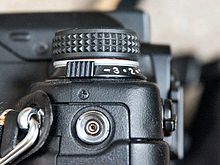Flash sync connection
When Sync terminal (also: PC Sync terminal , Prontor Compur synchronous connection , sync socket , sync terminal ) refers to a standardized socket on cameras , to the non-system flash units or flash systems to be connected. The flash sync connection is standardized under ISO standard 519.
technology
A sync cable is connected to the sync socket, which in turn is connected to the flash unit; the connection is independent of the polarity of the ignition circuit . When operating the flash via the sync socket, camera-specific flash control functions such as switch-on and flash readiness signal, automatic switching to synchro time, automatic TTL or flash confirmation, which are available with a system flash unit connected to the hot shoe , are lost. In contrast to the center contact hot shoe, which works almost exclusively with the so-called X synchronization , some cameras offer synchronization methods that can be adapted to different flash units on the sync socket.
history
A flash synchro connection was part of the standard equipment of most cameras until the introduction of the standard center contact hot shoe , but its use quickly declined and was generally only used in higher quality cameras, especially single-lens reflex cameras, and in studio photography . Compact digital cameras and entry-level digital SLR cameras usually do not have a sync socket.
Some older cameras such as the Contax IIa and Contax IIIa initially only had a non- standardized synchro connection for flash units. Some instant cameras and very simple roll film cameras also used different sync connections.
Instructions for use
The camera should be switched to manual mode for flash control via the synchronous connection; For flash synchronization, a shutter speed must be set that is longer than the flash synchronization time of the camera. When connecting older flash units to electronically controlled cameras, regardless of whether they are digital or film-based, it is important to ensure that the flash unit has a so-called low-voltage ignition, as otherwise the camera electronics can be destroyed.
As an alternative to connection via a synchro cable, a studio flash can also be triggered and controlled wirelessly via radio or a photocell or a photodiode , provided the camera has a built-in flash unit, a system flash unit is connected or the flash system has a corresponding control unit.


